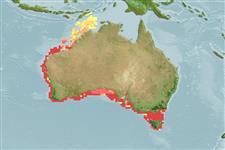Actinopterygii (ray-finned fishes) >
Pleuronectiformes (Flatfishes) >
Pleuronectidae (Righteye flounders) > Rhombosoleinae
Etymology: Ammotretis: Greek, ammos = sand + Greek, tretos, -e, -on = full of holes (Ref. 45335).
Environment / Climate / Range
Ecology
Marine; demersal; depth range 40 - 80 m (Ref. 33839). Temperate, preferred ?
Eastern Indian Ocean: Australia (South Australia, Victoria and Tasmania).
Size / Weight / Age
Maturity: Lm ? range ? - ? cm
Max length : 23.0 cm TL male/unsexed; (Ref. 9563)
Short description
Morphology | Morphometrics
Dorsal
soft rays
(total): 77-82;
Anal
soft rays: 54 - 58. Body deep (46-50% SL). Snout extended into a hook-like process projecting downwards in front of small, oblique mouth. Scales very small, rather firmly attached; mostly ctenoid on ocular side, mostly cycloid on blind side. Pelvic fin rays on right side 9-10, left 6. Caudal fin rays 14 (Ref. 33839).
Found inshore off beaches and on the continental shelf (Ref. 9563).
Life cycle and mating behavior
Maturity | Reproduction | Spawning | Eggs | Fecundity | Larvae
May, J.L. and J.G.H. Maxwell, 1986. Trawl fish from temperate waters of Australia. CSIRO Division of Fisheries Research, Tasmania. 492 p. (Ref. 9563)
IUCN Red List Status (Ref. 115185)
CITES (Ref. 94142)
Not Evaluated
Threat to humans
Harmless
Human uses
More information
Common namesSynonymsMetabolismPredatorsEcotoxicologyReproductionMaturitySpawningFecundityEggsEgg development
Age/SizeGrowthLength-weightLength-lengthLength-frequenciesMorphometricsMorphologyLarvaeLarval dynamicsRecruitmentAbundance
ReferencesAquacultureAquaculture profileStrainsGeneticsAllele frequenciesHeritabilityDiseasesProcessingMass conversion
Tools
Special reports
Download XML
Internet sources
